Taxable Income from Timber Removal
VerifiedAdded on 2020/03/04
|8
|2333
|57
AI Summary
This assignment delves into the tax implications of removing timber from land. It examines how payments received for timber rights or removal constitute assessable income under Australian tax law (specifically section 6). The example scenario involves Bill, who receives payment from a company to remove timber from his land. The analysis clarifies whether this income is considered ordinary business activity or subject to capital gains tax, emphasizing the importance of legal provisions in determining taxable income.
Contribute Materials
Your contribution can guide someone’s learning journey. Share your
documents today.
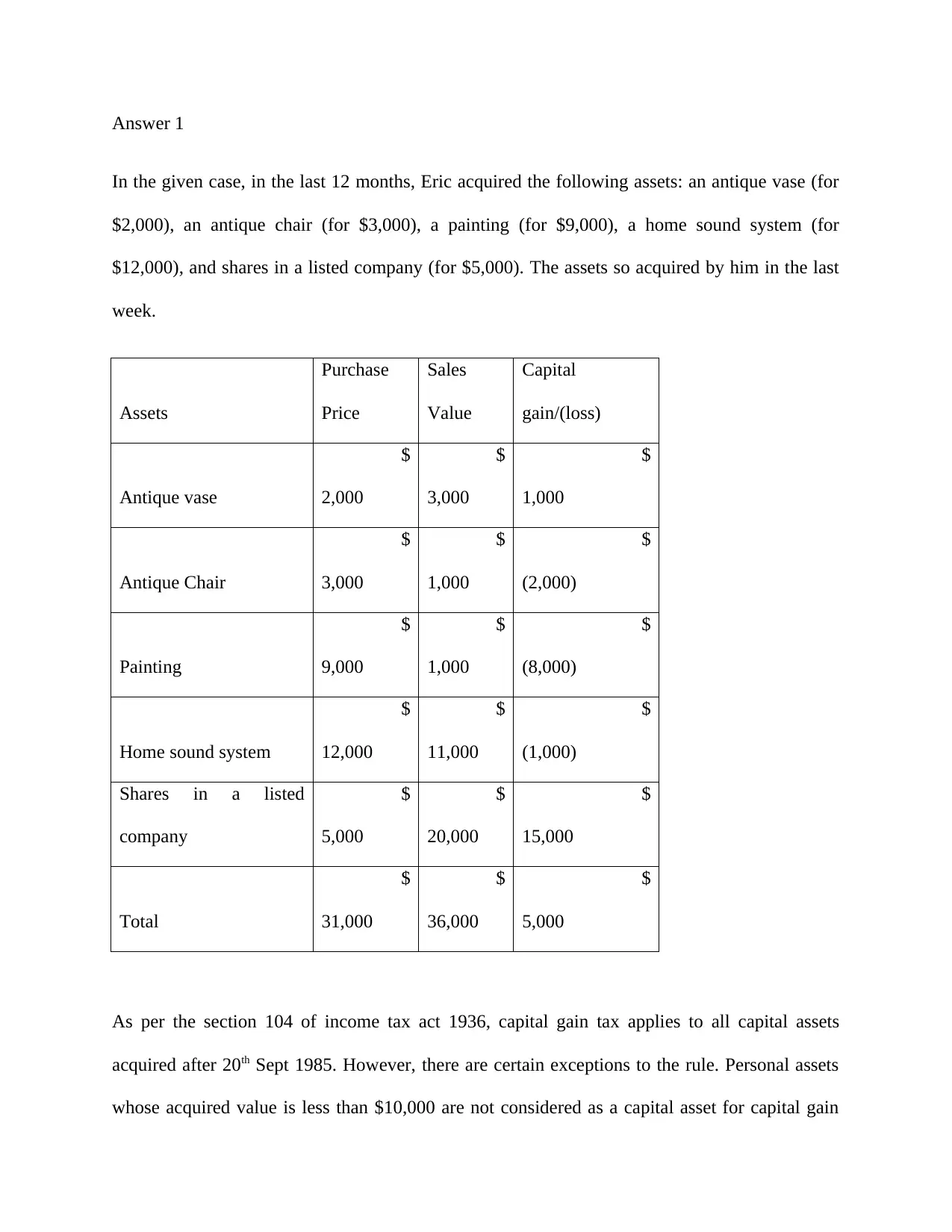
Answer 1
In the given case, in the last 12 months, Eric acquired the following assets: an antique vase (for
$2,000), an antique chair (for $3,000), a painting (for $9,000), a home sound system (for
$12,000), and shares in a listed company (for $5,000). The assets so acquired by him in the last
week.
Assets
Purchase
Price
Sales
Value
Capital
gain/(loss)
Antique vase
$
2,000
$
3,000
$
1,000
Antique Chair
$
3,000
$
1,000
$
(2,000)
Painting
$
9,000
$
1,000
$
(8,000)
Home sound system
$
12,000
$
11,000
$
(1,000)
Shares in a listed
company
$
5,000
$
20,000
$
15,000
Total
$
31,000
$
36,000
$
5,000
As per the section 104 of income tax act 1936, capital gain tax applies to all capital assets
acquired after 20th Sept 1985. However, there are certain exceptions to the rule. Personal assets
whose acquired value is less than $10,000 are not considered as a capital asset for capital gain
In the given case, in the last 12 months, Eric acquired the following assets: an antique vase (for
$2,000), an antique chair (for $3,000), a painting (for $9,000), a home sound system (for
$12,000), and shares in a listed company (for $5,000). The assets so acquired by him in the last
week.
Assets
Purchase
Price
Sales
Value
Capital
gain/(loss)
Antique vase
$
2,000
$
3,000
$
1,000
Antique Chair
$
3,000
$
1,000
$
(2,000)
Painting
$
9,000
$
1,000
$
(8,000)
Home sound system
$
12,000
$
11,000
$
(1,000)
Shares in a listed
company
$
5,000
$
20,000
$
15,000
Total
$
31,000
$
36,000
$
5,000
As per the section 104 of income tax act 1936, capital gain tax applies to all capital assets
acquired after 20th Sept 1985. However, there are certain exceptions to the rule. Personal assets
whose acquired value is less than $10,000 are not considered as a capital asset for capital gain
Secure Best Marks with AI Grader
Need help grading? Try our AI Grader for instant feedback on your assignments.
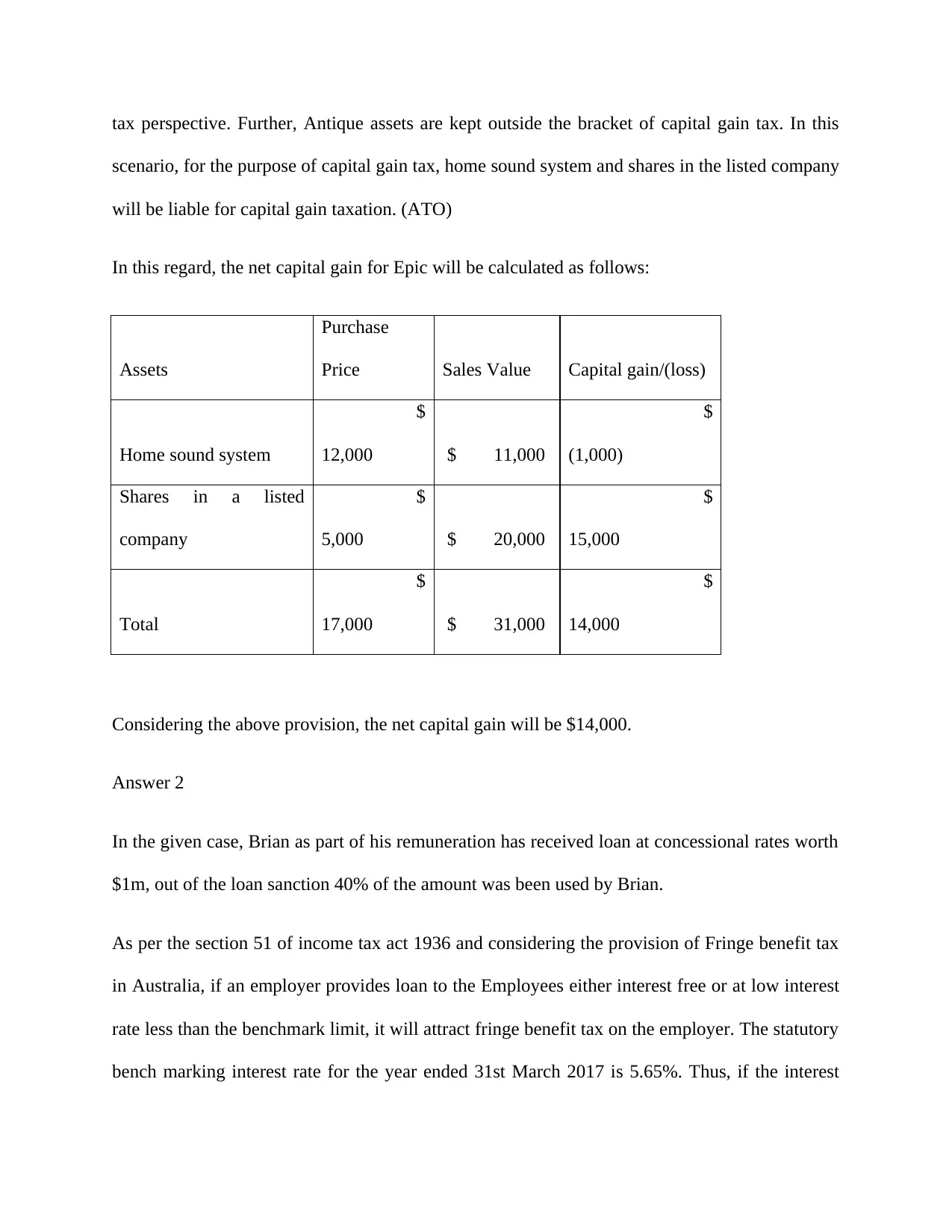
tax perspective. Further, Antique assets are kept outside the bracket of capital gain tax. In this
scenario, for the purpose of capital gain tax, home sound system and shares in the listed company
will be liable for capital gain taxation. (ATO)
In this regard, the net capital gain for Epic will be calculated as follows:
Assets
Purchase
Price Sales Value Capital gain/(loss)
Home sound system
$
12,000 $ 11,000
$
(1,000)
Shares in a listed
company
$
5,000 $ 20,000
$
15,000
Total
$
17,000 $ 31,000
$
14,000
Considering the above provision, the net capital gain will be $14,000.
Answer 2
In the given case, Brian as part of his remuneration has received loan at concessional rates worth
$1m, out of the loan sanction 40% of the amount was been used by Brian.
As per the section 51 of income tax act 1936 and considering the provision of Fringe benefit tax
in Australia, if an employer provides loan to the Employees either interest free or at low interest
rate less than the benchmark limit, it will attract fringe benefit tax on the employer. The statutory
bench marking interest rate for the year ended 31st March 2017 is 5.65%. Thus, if the interest
scenario, for the purpose of capital gain tax, home sound system and shares in the listed company
will be liable for capital gain taxation. (ATO)
In this regard, the net capital gain for Epic will be calculated as follows:
Assets
Purchase
Price Sales Value Capital gain/(loss)
Home sound system
$
12,000 $ 11,000
$
(1,000)
Shares in a listed
company
$
5,000 $ 20,000
$
15,000
Total
$
17,000 $ 31,000
$
14,000
Considering the above provision, the net capital gain will be $14,000.
Answer 2
In the given case, Brian as part of his remuneration has received loan at concessional rates worth
$1m, out of the loan sanction 40% of the amount was been used by Brian.
As per the section 51 of income tax act 1936 and considering the provision of Fringe benefit tax
in Australia, if an employer provides loan to the Employees either interest free or at low interest
rate less than the benchmark limit, it will attract fringe benefit tax on the employer. The statutory
bench marking interest rate for the year ended 31st March 2017 is 5.65%. Thus, if the interest
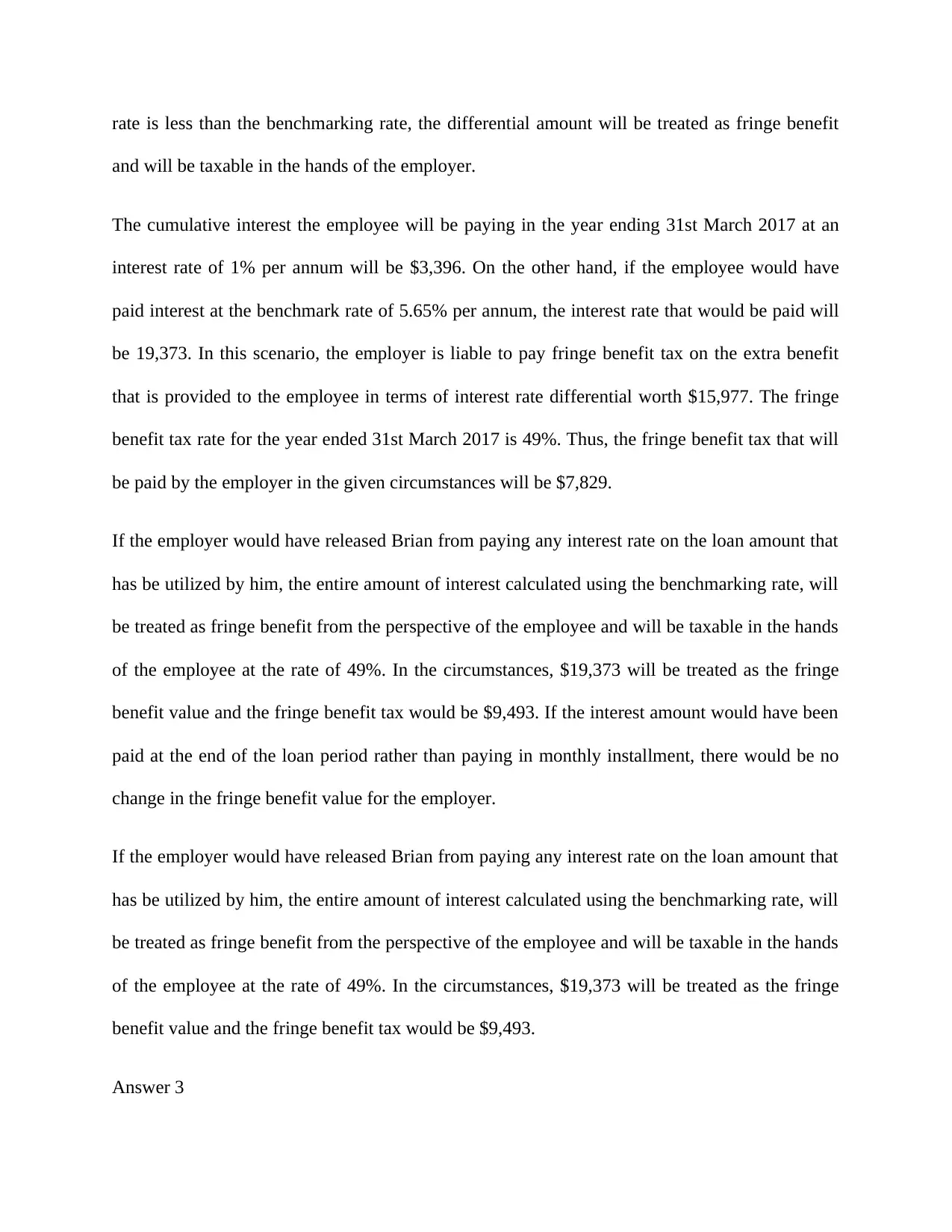
rate is less than the benchmarking rate, the differential amount will be treated as fringe benefit
and will be taxable in the hands of the employer.
The cumulative interest the employee will be paying in the year ending 31st March 2017 at an
interest rate of 1% per annum will be $3,396. On the other hand, if the employee would have
paid interest at the benchmark rate of 5.65% per annum, the interest rate that would be paid will
be 19,373. In this scenario, the employer is liable to pay fringe benefit tax on the extra benefit
that is provided to the employee in terms of interest rate differential worth $15,977. The fringe
benefit tax rate for the year ended 31st March 2017 is 49%. Thus, the fringe benefit tax that will
be paid by the employer in the given circumstances will be $7,829.
If the employer would have released Brian from paying any interest rate on the loan amount that
has be utilized by him, the entire amount of interest calculated using the benchmarking rate, will
be treated as fringe benefit from the perspective of the employee and will be taxable in the hands
of the employee at the rate of 49%. In the circumstances, $19,373 will be treated as the fringe
benefit value and the fringe benefit tax would be $9,493. If the interest amount would have been
paid at the end of the loan period rather than paying in monthly installment, there would be no
change in the fringe benefit value for the employer.
If the employer would have released Brian from paying any interest rate on the loan amount that
has be utilized by him, the entire amount of interest calculated using the benchmarking rate, will
be treated as fringe benefit from the perspective of the employee and will be taxable in the hands
of the employee at the rate of 49%. In the circumstances, $19,373 will be treated as the fringe
benefit value and the fringe benefit tax would be $9,493.
Answer 3
and will be taxable in the hands of the employer.
The cumulative interest the employee will be paying in the year ending 31st March 2017 at an
interest rate of 1% per annum will be $3,396. On the other hand, if the employee would have
paid interest at the benchmark rate of 5.65% per annum, the interest rate that would be paid will
be 19,373. In this scenario, the employer is liable to pay fringe benefit tax on the extra benefit
that is provided to the employee in terms of interest rate differential worth $15,977. The fringe
benefit tax rate for the year ended 31st March 2017 is 49%. Thus, the fringe benefit tax that will
be paid by the employer in the given circumstances will be $7,829.
If the employer would have released Brian from paying any interest rate on the loan amount that
has be utilized by him, the entire amount of interest calculated using the benchmarking rate, will
be treated as fringe benefit from the perspective of the employee and will be taxable in the hands
of the employee at the rate of 49%. In the circumstances, $19,373 will be treated as the fringe
benefit value and the fringe benefit tax would be $9,493. If the interest amount would have been
paid at the end of the loan period rather than paying in monthly installment, there would be no
change in the fringe benefit value for the employer.
If the employer would have released Brian from paying any interest rate on the loan amount that
has be utilized by him, the entire amount of interest calculated using the benchmarking rate, will
be treated as fringe benefit from the perspective of the employee and will be taxable in the hands
of the employee at the rate of 49%. In the circumstances, $19,373 will be treated as the fringe
benefit value and the fringe benefit tax would be $9,493.
Answer 3
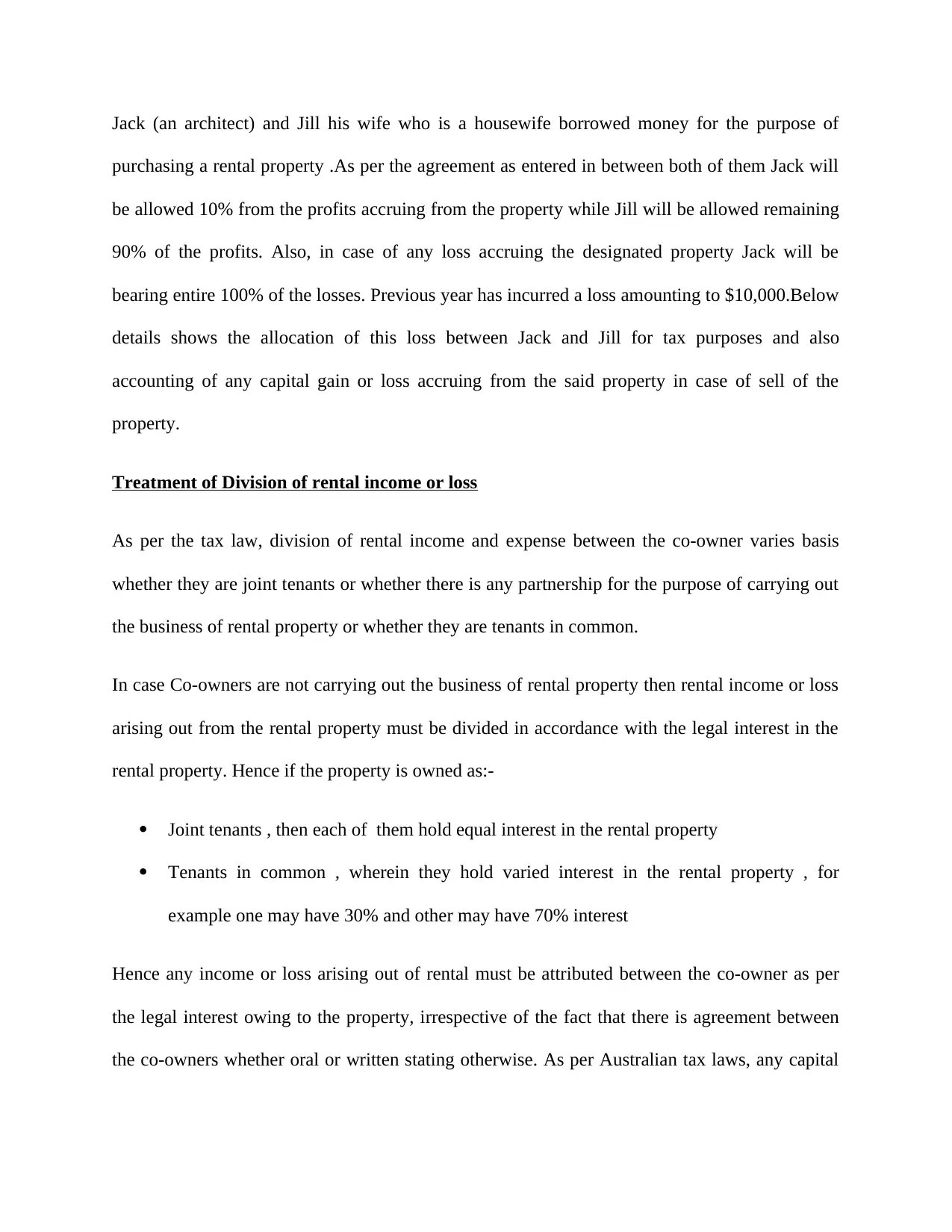
Jack (an architect) and Jill his wife who is a housewife borrowed money for the purpose of
purchasing a rental property .As per the agreement as entered in between both of them Jack will
be allowed 10% from the profits accruing from the property while Jill will be allowed remaining
90% of the profits. Also, in case of any loss accruing the designated property Jack will be
bearing entire 100% of the losses. Previous year has incurred a loss amounting to $10,000.Below
details shows the allocation of this loss between Jack and Jill for tax purposes and also
accounting of any capital gain or loss accruing from the said property in case of sell of the
property.
Treatment of Division of rental income or loss
As per the tax law, division of rental income and expense between the co-owner varies basis
whether they are joint tenants or whether there is any partnership for the purpose of carrying out
the business of rental property or whether they are tenants in common.
In case Co-owners are not carrying out the business of rental property then rental income or loss
arising out from the rental property must be divided in accordance with the legal interest in the
rental property. Hence if the property is owned as:-
Joint tenants , then each of them hold equal interest in the rental property
Tenants in common , wherein they hold varied interest in the rental property , for
example one may have 30% and other may have 70% interest
Hence any income or loss arising out of rental must be attributed between the co-owner as per
the legal interest owing to the property, irrespective of the fact that there is agreement between
the co-owners whether oral or written stating otherwise. As per Australian tax laws, any capital
purchasing a rental property .As per the agreement as entered in between both of them Jack will
be allowed 10% from the profits accruing from the property while Jill will be allowed remaining
90% of the profits. Also, in case of any loss accruing the designated property Jack will be
bearing entire 100% of the losses. Previous year has incurred a loss amounting to $10,000.Below
details shows the allocation of this loss between Jack and Jill for tax purposes and also
accounting of any capital gain or loss accruing from the said property in case of sell of the
property.
Treatment of Division of rental income or loss
As per the tax law, division of rental income and expense between the co-owner varies basis
whether they are joint tenants or whether there is any partnership for the purpose of carrying out
the business of rental property or whether they are tenants in common.
In case Co-owners are not carrying out the business of rental property then rental income or loss
arising out from the rental property must be divided in accordance with the legal interest in the
rental property. Hence if the property is owned as:-
Joint tenants , then each of them hold equal interest in the rental property
Tenants in common , wherein they hold varied interest in the rental property , for
example one may have 30% and other may have 70% interest
Hence any income or loss arising out of rental must be attributed between the co-owner as per
the legal interest owing to the property, irrespective of the fact that there is agreement between
the co-owners whether oral or written stating otherwise. As per Australian tax laws, any capital
Secure Best Marks with AI Grader
Need help grading? Try our AI Grader for instant feedback on your assignments.
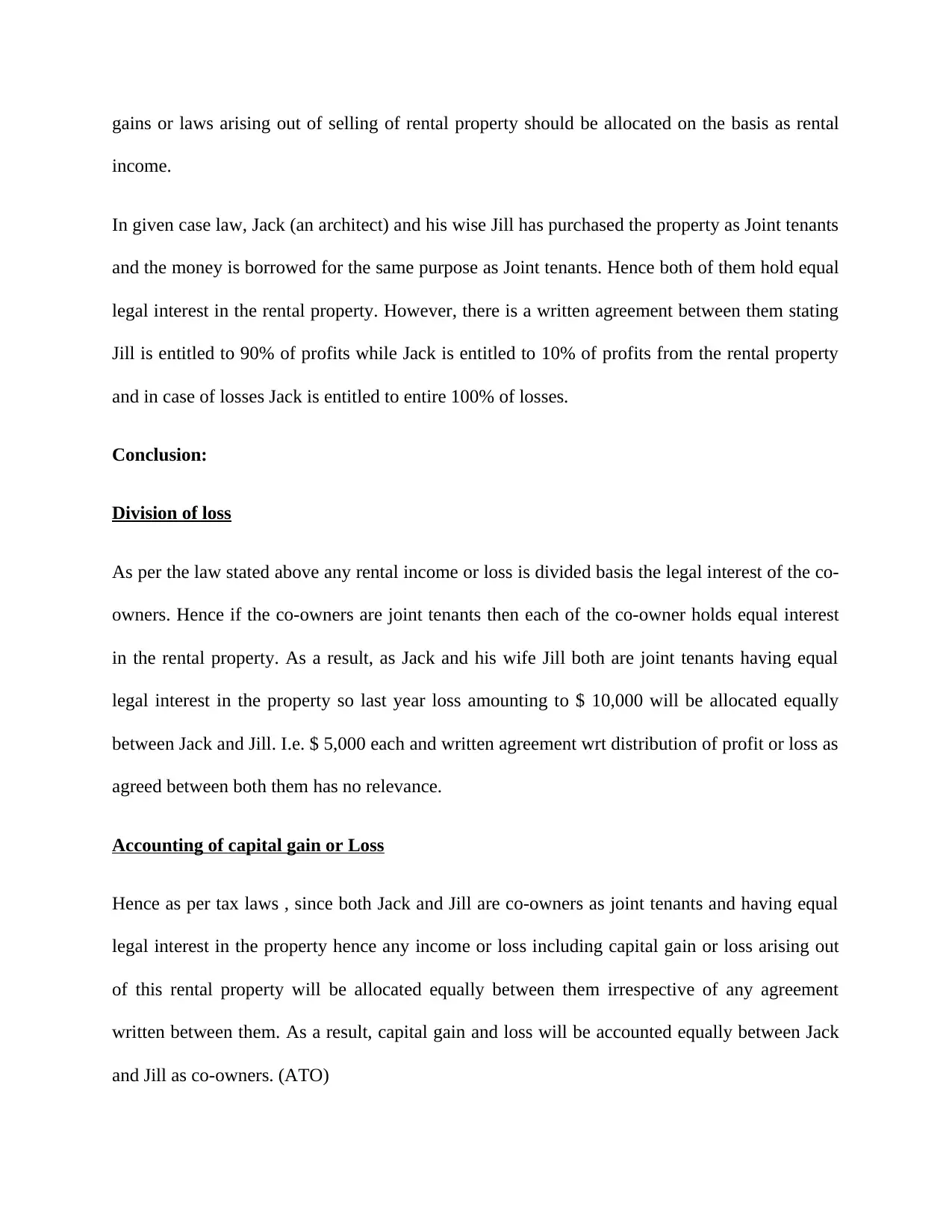
gains or laws arising out of selling of rental property should be allocated on the basis as rental
income.
In given case law, Jack (an architect) and his wise Jill has purchased the property as Joint tenants
and the money is borrowed for the same purpose as Joint tenants. Hence both of them hold equal
legal interest in the rental property. However, there is a written agreement between them stating
Jill is entitled to 90% of profits while Jack is entitled to 10% of profits from the rental property
and in case of losses Jack is entitled to entire 100% of losses.
Conclusion:
Division of loss
As per the law stated above any rental income or loss is divided basis the legal interest of the co-
owners. Hence if the co-owners are joint tenants then each of the co-owner holds equal interest
in the rental property. As a result, as Jack and his wife Jill both are joint tenants having equal
legal interest in the property so last year loss amounting to $ 10,000 will be allocated equally
between Jack and Jill. I.e. $ 5,000 each and written agreement wrt distribution of profit or loss as
agreed between both them has no relevance.
Accounting of capital gain or Loss
Hence as per tax laws , since both Jack and Jill are co-owners as joint tenants and having equal
legal interest in the property hence any income or loss including capital gain or loss arising out
of this rental property will be allocated equally between them irrespective of any agreement
written between them. As a result, capital gain and loss will be accounted equally between Jack
and Jill as co-owners. (ATO)
income.
In given case law, Jack (an architect) and his wise Jill has purchased the property as Joint tenants
and the money is borrowed for the same purpose as Joint tenants. Hence both of them hold equal
legal interest in the rental property. However, there is a written agreement between them stating
Jill is entitled to 90% of profits while Jack is entitled to 10% of profits from the rental property
and in case of losses Jack is entitled to entire 100% of losses.
Conclusion:
Division of loss
As per the law stated above any rental income or loss is divided basis the legal interest of the co-
owners. Hence if the co-owners are joint tenants then each of the co-owner holds equal interest
in the rental property. As a result, as Jack and his wife Jill both are joint tenants having equal
legal interest in the property so last year loss amounting to $ 10,000 will be allocated equally
between Jack and Jill. I.e. $ 5,000 each and written agreement wrt distribution of profit or loss as
agreed between both them has no relevance.
Accounting of capital gain or Loss
Hence as per tax laws , since both Jack and Jill are co-owners as joint tenants and having equal
legal interest in the property hence any income or loss including capital gain or loss arising out
of this rental property will be allocated equally between them irrespective of any agreement
written between them. As a result, capital gain and loss will be accounted equally between Jack
and Jill as co-owners. (ATO)
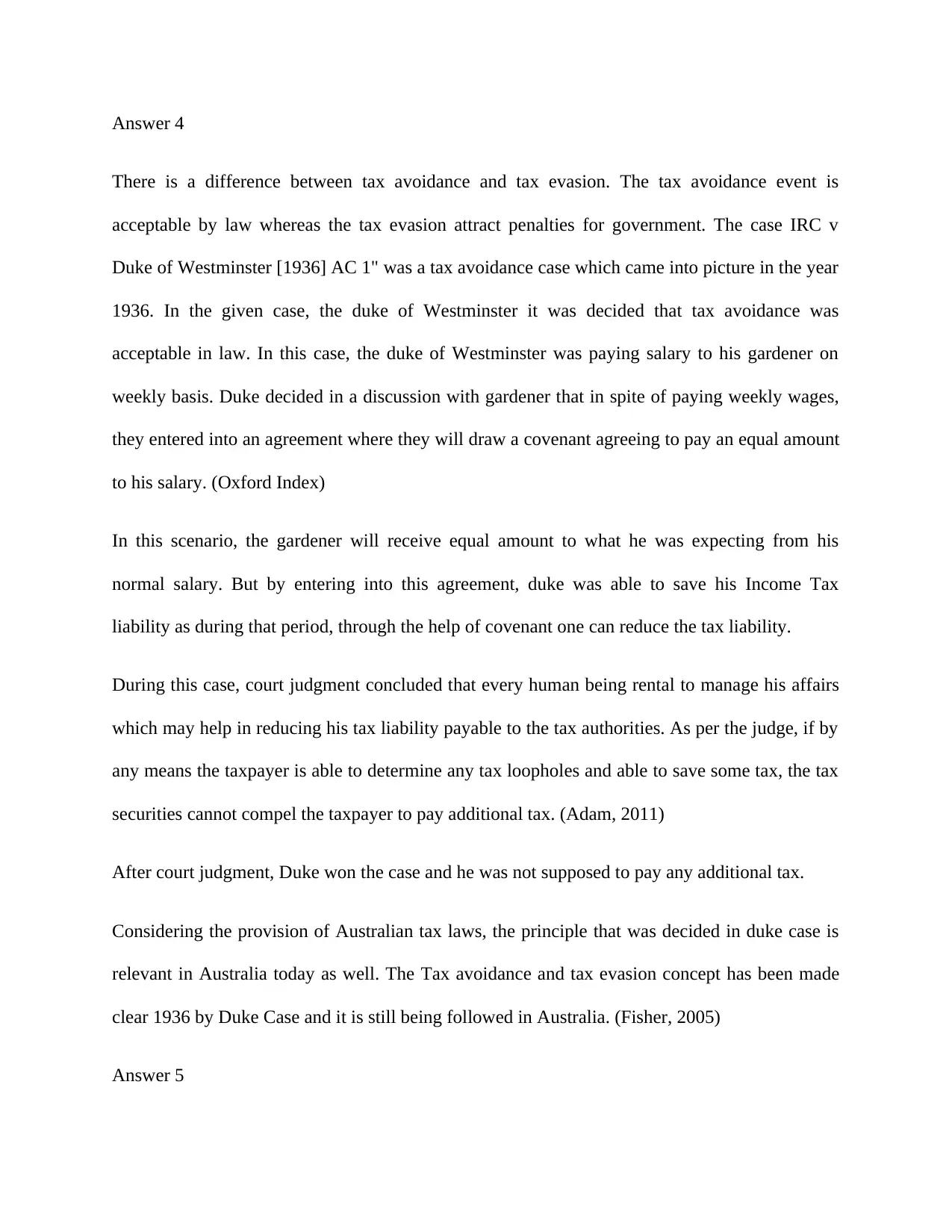
Answer 4
There is a difference between tax avoidance and tax evasion. The tax avoidance event is
acceptable by law whereas the tax evasion attract penalties for government. The case IRC v
Duke of Westminster [1936] AC 1" was a tax avoidance case which came into picture in the year
1936. In the given case, the duke of Westminster it was decided that tax avoidance was
acceptable in law. In this case, the duke of Westminster was paying salary to his gardener on
weekly basis. Duke decided in a discussion with gardener that in spite of paying weekly wages,
they entered into an agreement where they will draw a covenant agreeing to pay an equal amount
to his salary. (Oxford Index)
In this scenario, the gardener will receive equal amount to what he was expecting from his
normal salary. But by entering into this agreement, duke was able to save his Income Tax
liability as during that period, through the help of covenant one can reduce the tax liability.
During this case, court judgment concluded that every human being rental to manage his affairs
which may help in reducing his tax liability payable to the tax authorities. As per the judge, if by
any means the taxpayer is able to determine any tax loopholes and able to save some tax, the tax
securities cannot compel the taxpayer to pay additional tax. (Adam, 2011)
After court judgment, Duke won the case and he was not supposed to pay any additional tax.
Considering the provision of Australian tax laws, the principle that was decided in duke case is
relevant in Australia today as well. The Tax avoidance and tax evasion concept has been made
clear 1936 by Duke Case and it is still being followed in Australia. (Fisher, 2005)
Answer 5
There is a difference between tax avoidance and tax evasion. The tax avoidance event is
acceptable by law whereas the tax evasion attract penalties for government. The case IRC v
Duke of Westminster [1936] AC 1" was a tax avoidance case which came into picture in the year
1936. In the given case, the duke of Westminster it was decided that tax avoidance was
acceptable in law. In this case, the duke of Westminster was paying salary to his gardener on
weekly basis. Duke decided in a discussion with gardener that in spite of paying weekly wages,
they entered into an agreement where they will draw a covenant agreeing to pay an equal amount
to his salary. (Oxford Index)
In this scenario, the gardener will receive equal amount to what he was expecting from his
normal salary. But by entering into this agreement, duke was able to save his Income Tax
liability as during that period, through the help of covenant one can reduce the tax liability.
During this case, court judgment concluded that every human being rental to manage his affairs
which may help in reducing his tax liability payable to the tax authorities. As per the judge, if by
any means the taxpayer is able to determine any tax loopholes and able to save some tax, the tax
securities cannot compel the taxpayer to pay additional tax. (Adam, 2011)
After court judgment, Duke won the case and he was not supposed to pay any additional tax.
Considering the provision of Australian tax laws, the principle that was decided in duke case is
relevant in Australia today as well. The Tax avoidance and tax evasion concept has been made
clear 1936 by Duke Case and it is still being followed in Australia. (Fisher, 2005)
Answer 5
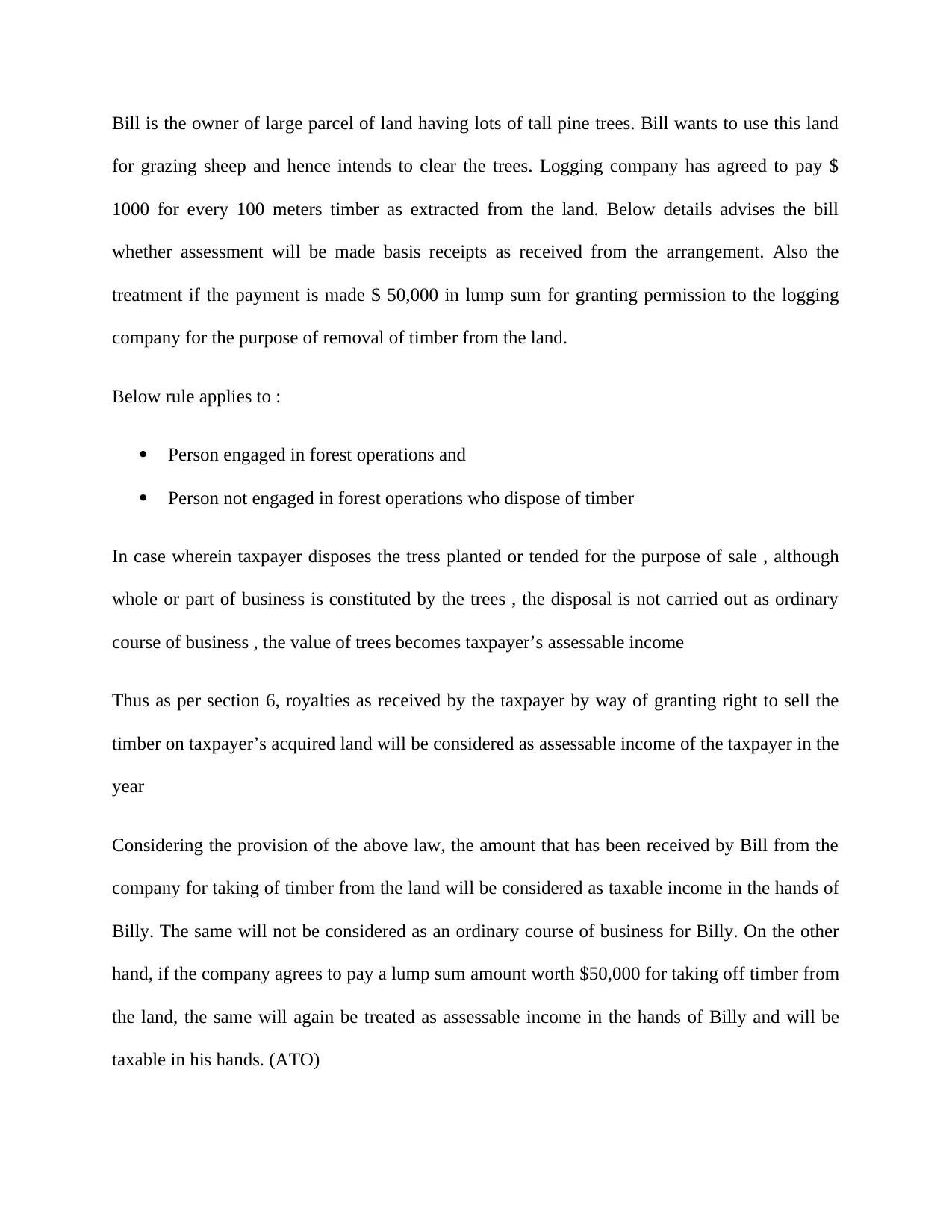
Bill is the owner of large parcel of land having lots of tall pine trees. Bill wants to use this land
for grazing sheep and hence intends to clear the trees. Logging company has agreed to pay $
1000 for every 100 meters timber as extracted from the land. Below details advises the bill
whether assessment will be made basis receipts as received from the arrangement. Also the
treatment if the payment is made $ 50,000 in lump sum for granting permission to the logging
company for the purpose of removal of timber from the land.
Below rule applies to :
Person engaged in forest operations and
Person not engaged in forest operations who dispose of timber
In case wherein taxpayer disposes the tress planted or tended for the purpose of sale , although
whole or part of business is constituted by the trees , the disposal is not carried out as ordinary
course of business , the value of trees becomes taxpayer’s assessable income
Thus as per section 6, royalties as received by the taxpayer by way of granting right to sell the
timber on taxpayer’s acquired land will be considered as assessable income of the taxpayer in the
year
Considering the provision of the above law, the amount that has been received by Bill from the
company for taking of timber from the land will be considered as taxable income in the hands of
Billy. The same will not be considered as an ordinary course of business for Billy. On the other
hand, if the company agrees to pay a lump sum amount worth $50,000 for taking off timber from
the land, the same will again be treated as assessable income in the hands of Billy and will be
taxable in his hands. (ATO)
for grazing sheep and hence intends to clear the trees. Logging company has agreed to pay $
1000 for every 100 meters timber as extracted from the land. Below details advises the bill
whether assessment will be made basis receipts as received from the arrangement. Also the
treatment if the payment is made $ 50,000 in lump sum for granting permission to the logging
company for the purpose of removal of timber from the land.
Below rule applies to :
Person engaged in forest operations and
Person not engaged in forest operations who dispose of timber
In case wherein taxpayer disposes the tress planted or tended for the purpose of sale , although
whole or part of business is constituted by the trees , the disposal is not carried out as ordinary
course of business , the value of trees becomes taxpayer’s assessable income
Thus as per section 6, royalties as received by the taxpayer by way of granting right to sell the
timber on taxpayer’s acquired land will be considered as assessable income of the taxpayer in the
year
Considering the provision of the above law, the amount that has been received by Bill from the
company for taking of timber from the land will be considered as taxable income in the hands of
Billy. The same will not be considered as an ordinary course of business for Billy. On the other
hand, if the company agrees to pay a lump sum amount worth $50,000 for taking off timber from
the land, the same will again be treated as assessable income in the hands of Billy and will be
taxable in his hands. (ATO)
Paraphrase This Document
Need a fresh take? Get an instant paraphrase of this document with our AI Paraphraser

Considering the provision of above laws, the amount that will be received by Billy from getting
the timber removed from the land will be taxable in his hands as normal assessable income.
the timber removed from the land will be taxable in his hands as normal assessable income.
1 out of 8
Related Documents
Your All-in-One AI-Powered Toolkit for Academic Success.
+13062052269
info@desklib.com
Available 24*7 on WhatsApp / Email
![[object Object]](/_next/static/media/star-bottom.7253800d.svg)
Unlock your academic potential
© 2024 | Zucol Services PVT LTD | All rights reserved.





